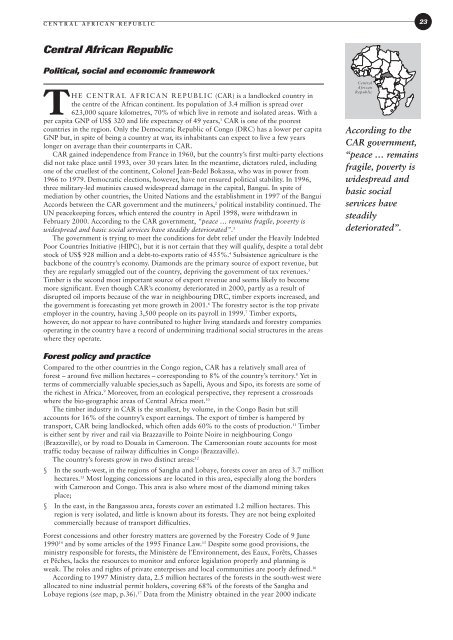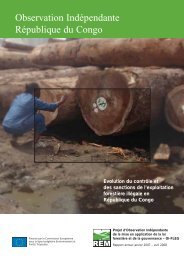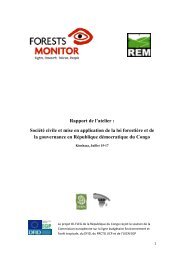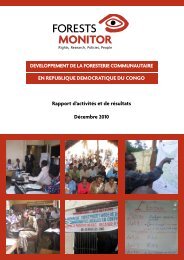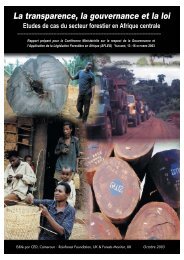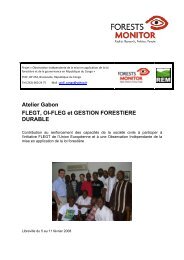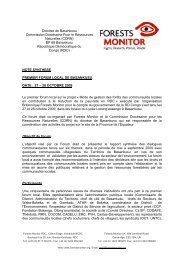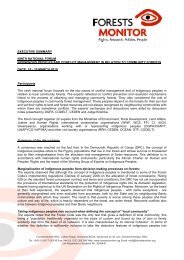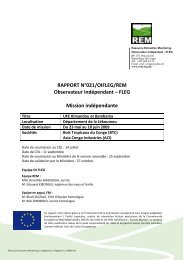Sold down the river - Salva le Foreste
Sold down the river - Salva le Foreste
Sold down the river - Salva le Foreste
You also want an ePaper? Increase the reach of your titles
YUMPU automatically turns print PDFs into web optimized ePapers that Google loves.
CENTRAL AFRICAN REPUBLIC 23Central African RepublicPolitical, social and economic frameworkTHE CENTRAL AFRICAN REPUBLIC (CAR) is a landlocked country in<strong>the</strong> centre of <strong>the</strong> African continent. Its population of 3.4 million is spread over623,000 square kilometres, 70% of which live in remote and isolated areas. With aper capita GNP of US$ 320 and life expectancy of 49 years, 1 CAR is one of <strong>the</strong> poorestcountries in <strong>the</strong> region. Only <strong>the</strong> Democratic Republic of Congo (DRC) has a lower per capitaGNP but, in spite of being a country at war, its inhabitants can expect to live a few yearslonger on average than <strong>the</strong>ir counterparts in CAR.CAR gained independence from France in 1960, but <strong>the</strong> country’s first multi-party e<strong>le</strong>ctionsdid not take place until 1993, over 30 years later. In <strong>the</strong> meantime, dictators ru<strong>le</strong>d, includingone of <strong>the</strong> cruel<strong>le</strong>st of <strong>the</strong> continent, Colonel Jean-Bedel Bokassa, who was in power from1966 to 1979. Democratic e<strong>le</strong>ctions, however, have not ensured political stability. In 1996,three military-<strong>le</strong>d mutinies caused widespread damage in <strong>the</strong> capital, Bangui. In spite ofmediation by o<strong>the</strong>r countries, <strong>the</strong> United Nations and <strong>the</strong> establishment in 1997 of <strong>the</strong> BanguiAccords between <strong>the</strong> CAR government and <strong>the</strong> mutineers, 2 political instability continued. TheUN peacekeeping forces, which entered <strong>the</strong> country in April 1998, were withdrawn inFebruary 2000. According to <strong>the</strong> CAR government, “peace … remains fragi<strong>le</strong>, poverty iswidespread and basic social services have steadily deteriorated”. 3The government is trying to meet <strong>the</strong> conditions for debt relief under <strong>the</strong> Heavily IndebtedPoor Countries Initiative (HIPC), but it is not certain that <strong>the</strong>y will qualify, despite a total debtstock of US$ 928 million and a debt-to-exports ratio of 455%. 4 Subsistence agriculture is <strong>the</strong>backbone of <strong>the</strong> country’s economy. Diamonds are <strong>the</strong> primary source of export revenue, but<strong>the</strong>y are regularly smugg<strong>le</strong>d out of <strong>the</strong> country, depriving <strong>the</strong> government of tax revenues. 5Timber is <strong>the</strong> second most important source of export revenue and seems likely to becomemore significant. Even though CAR’s economy deteriorated in 2000, partly as a result ofdisrupted oil imports because of <strong>the</strong> war in neighbouring DRC, timber exports increased, and<strong>the</strong> government is forecasting yet more growth in 2001. 6 The forestry sector is <strong>the</strong> top privateemployer in <strong>the</strong> country, having 3,500 peop<strong>le</strong> on its payroll in 1999. 7 Timber exports,however, do not appear to have contributed to higher living standards and forestry companiesoperating in <strong>the</strong> country have a record of undermining traditional social structures in <strong>the</strong> areaswhere <strong>the</strong>y operate.CentralAfricanRepublicAccording to <strong>the</strong>CAR government,“peace … remainsfragi<strong>le</strong>, poverty iswidespread andbasic socialservices havesteadilydeteriorated”.Forest policy and practiceCompared to <strong>the</strong> o<strong>the</strong>r countries in <strong>the</strong> Congo region, CAR has a relatively small area offorest – around five million hectares – corresponding to 8% of <strong>the</strong> country’s territory. 8 Yet interms of commercially valuab<strong>le</strong> species,such as Sapelli, Ayous and Sipo, its forests are some of<strong>the</strong> richest in Africa. 9 Moreover, from an ecological perspective, <strong>the</strong>y represent a crossroadswhere <strong>the</strong> bio-geographic areas of Central Africa meet. 10The timber industry in CAR is <strong>the</strong> smal<strong>le</strong>st, by volume, in <strong>the</strong> Congo Basin but stillaccounts for 16% of <strong>the</strong> country’s export earnings. The export of timber is hampered bytransport, CAR being landlocked, which often adds 60% to <strong>the</strong> costs of production. 11 Timberis ei<strong>the</strong>r sent by <strong>river</strong> and rail via Brazzavil<strong>le</strong> to Pointe Noire in neighbouring Congo(Brazzavil<strong>le</strong>), or by road to Douala in Cameroon. The Cameroonian route accounts for mosttraffic today because of railway difficulties in Congo (Brazzavil<strong>le</strong>).The country’s forests grow in two distinct areas: 12§ In <strong>the</strong> south-west, in <strong>the</strong> regions of Sangha and Lobaye, forests cover an area of 3.7 millionhectares. 13 Most logging concessions are located in this area, especially along <strong>the</strong> borderswith Cameroon and Congo. This area is also where most of <strong>the</strong> diamond mining takesplace;§ In <strong>the</strong> east, in <strong>the</strong> Bangassou area, forests cover an estimated 1.2 million hectares. Thisregion is very isolated, and litt<strong>le</strong> is known about its forests. They are not being exploitedcommercially because of transport difficulties.Forest concessions and o<strong>the</strong>r forestry matters are governed by <strong>the</strong> Forestry Code of 9 June1990 14 and by some artic<strong>le</strong>s of <strong>the</strong> 1995 Finance Law. 15 Despite some good provisions, <strong>the</strong>ministry responsib<strong>le</strong> for forests, <strong>the</strong> Ministère de l’Environnement, des Eaux, Forêts, Chasseset Pêches, lacks <strong>the</strong> resources to monitor and enforce <strong>le</strong>gislation properly and planning isweak. The ro<strong>le</strong>s and rights of private enterprises and local communities are poorly defined. 16According to 1997 Ministry data, 2.5 million hectares of <strong>the</strong> forests in <strong>the</strong> south-west wereallocated to nine industrial permit holders, covering 68% of <strong>the</strong> forests of <strong>the</strong> Sangha andLobaye regions (see map, p.36). 17 Data from <strong>the</strong> Ministry obtained in <strong>the</strong> year 2000 indicate


